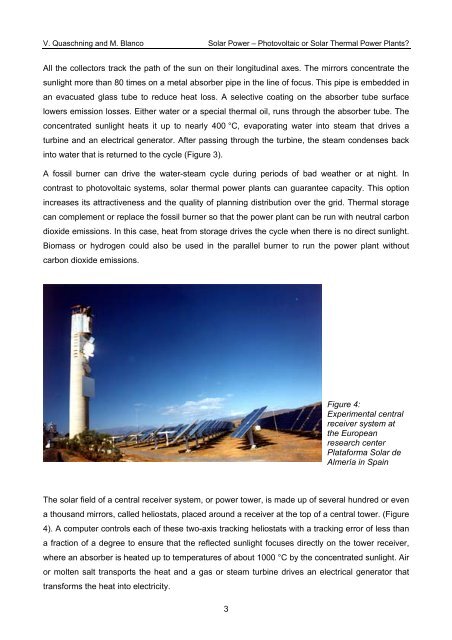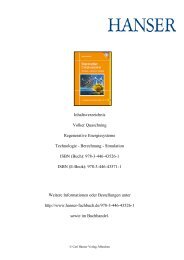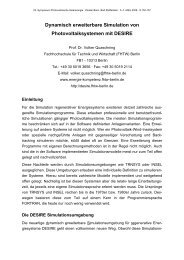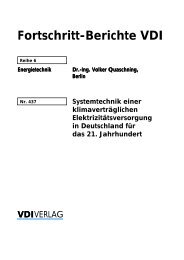Photovoltaics or Solar Thermal Power Plants? - Volker Quaschning
Photovoltaics or Solar Thermal Power Plants? - Volker Quaschning
Photovoltaics or Solar Thermal Power Plants? - Volker Quaschning
You also want an ePaper? Increase the reach of your titles
YUMPU automatically turns print PDFs into web optimized ePapers that Google loves.
V. <strong>Quaschning</strong> and M. Blanco <strong>Solar</strong> <strong>Power</strong> – Photovoltaic <strong>or</strong> <strong>Solar</strong> <strong>Thermal</strong> <strong>Power</strong> <strong>Plants</strong>?All the collect<strong>or</strong>s track the path of the sun on their longitudinal axes. The mirr<strong>or</strong>s concentrate thesunlight m<strong>or</strong>e than 80 times on a metal abs<strong>or</strong>ber pipe in the line of focus. This pipe is embedded inan evacuated glass tube to reduce heat loss. A selective coating on the abs<strong>or</strong>ber tube surfacelowers emission losses. Either water <strong>or</strong> a special thermal oil, runs through the abs<strong>or</strong>ber tube. Theconcentrated sunlight heats it up to nearly 400 °C, evap<strong>or</strong>ating water into steam that drives aturbine and an electrical generat<strong>or</strong>. After passing through the turbine, the steam condenses backinto water that is returned to the cycle (Figure 3).A fossil burner can drive the water-steam cycle during periods of bad weather <strong>or</strong> at night. Incontrast to photovoltaic systems, solar thermal power plants can guarantee capacity. This optionincreases its attractiveness and the quality of planning distribution over the grid. <strong>Thermal</strong> st<strong>or</strong>agecan complement <strong>or</strong> replace the fossil burner so that the power plant can be run with neutral carbondioxide emissions. In this case, heat from st<strong>or</strong>age drives the cycle when there is no direct sunlight.Biomass <strong>or</strong> hydrogen could also be used in the parallel burner to run the power plant withoutcarbon dioxide emissions.Figure 4:Experimental centralreceiver system atthe Europeanresearch centerPlataf<strong>or</strong>ma <strong>Solar</strong> deAlmería in SpainThe solar field of a central receiver system, <strong>or</strong> power tower, is made up of several hundred <strong>or</strong> evena thousand mirr<strong>or</strong>s, called heliostats, placed around a receiver at the top of a central tower. (Figure4). A computer controls each of these two-axis tracking heliostats with a tracking err<strong>or</strong> of less thana fraction of a degree to ensure that the reflected sunlight focuses directly on the tower receiver,where an abs<strong>or</strong>ber is heated up to temperatures of about 1000 °C by the concentrated sunlight. Air<strong>or</strong> molten salt transp<strong>or</strong>ts the heat and a gas <strong>or</strong> steam turbine drives an electrical generat<strong>or</strong> thattransf<strong>or</strong>ms the heat into electricity.3









